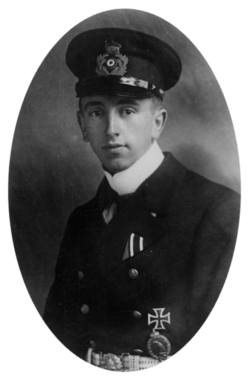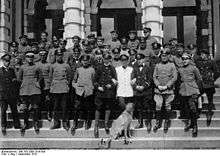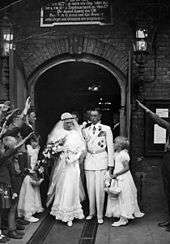Theo Osterkamp
Theodor "Theo" Osterkamp (15 April 1892 – 2 January 1975)[2] was a German fighter pilot during World War I and World War II. A flying ace, he achieved 32 victories in World War I.[3] In World War II, he led Jagdgeschwader 51 through the Battle of Britain and claimed a further 6 victories, in the process becoming one of only a few men to score victories in both world wars.
Theo Osterkamp | |
|---|---|
 Theo Osterkamp | |
| Nickname(s) | Onkel (Uncle)[1] |
| Born | 15 April 1892 Düren, Rhine Province, Kingdom of Prussia, German Empire |
| Died | 2 January 1975 (aged 82) Baden-Baden, Baden-Württemberg, West Germany |
| Allegiance | |
| Service/ | |
| Years of service | 1914–44 |
| Rank | Generalleutnant |
| Commands held | JG 51 |
| Battles/wars | |
| Awards | |
Early life and World War I
Osterkamp was born in Aschersleben,[4] modern day Saxony-Anhalt. When the First World War started he was studying forestry but decided to enlist in the German Army.[4] He was rejected for service due to his "slight build"[4] and he instead enlisted in the Marinefliegerkorps in August 1914.[4] He then flew with the 2. Marine-Fliegerabteilung in Flanders. During 1915–1916, he served as an air observer, and became the first German pilot to fly a land-based aircraft to England on a reconnaissance-mission. Osterkamp claimed his first (but unconfirmed) kill on 6 September 1916 as an observer to pilot Leutnant zur See Wilhelm Mattheus in a LVG C.II two-seater aircraft.[4] In March 1917, he joined the Kampffliegerschule (Combat pilot school) in Putzig and then joined Marine Feld Jagdstaffel 1 on the 14th of April 1917[4] On 21 March 1917, Leutnant Osterkamp took command of Marine Feld Jagdstaffel 2 [5] He scored a total of 32 victories during the war,[3] and was awarded the Prussian military order Pour le Mérite[3] on 2 September 1918,[6] and was one of the last individuals to receive it.

2)Gotthard Sachsenberg.
Interwar years

Osterkamp joined the new Luftwaffe on August 1, 1933 with the rank of Hauptmann. [7] He also participated in the second, third and fourth FAI International Tourist Plane Contest Challenge 1930 (11th place), Challenge 1932 (12th place) and Challenge 1934 (5th place). By the time the war broke out in September 1939 he was a Oberstleutnant in command of the Jagdfliegerschule 1 (JF1).[7]
World War II
On 19 September 1939, Oberst Osterkamp was appointed Geschwaderkommodore of Jagdgeschwader 51 (JG 51—51st Fighter Wing).[Note 1][7] During the Battle of France, he claimed four victories.[2] During the Kanalkampf period of the Battle of Britain in July 1940, he claimed a further two victories, (a Bristol Blenheim on 1 June and a Spitfire on 13 July 1940) bringing his total to six. He was replaced as commander of JG 51 by Werner Mölders on 23 July with the latter formally taking command on the 27th of July. [8][9] Promoted to Generalmajor, Osterkamp was awarded his Knight's Cross of the Iron Cross on 22 August 1940.[10] Following his replacement in JG 51, Osterkamp was appointed Jagdfliegerführer 2, the commander of fighter aircraft in Luftflotte 2.[11]
On 1 August 1942, he was transferred to Luftgaustab z.b.V. Afrika. On 5 April 1943, he was appointed Jagdfliegerführer Sizilien and served until replaced on 15 June by Adolf Galland. He then served in a number of staff positions until being appointed Inspekteur der Luftwaffen-Bodenorganisation (Inspector of Luftwaffe ground organisation) in 1944. After criticism from High Command, he was dismissed from the service on 21 December 1944.
Post-war career
In 1960, he was appointed honorary chairman of the Gemeinschaft der Jagdflieger, the Association of Fighter Pilots.[12]
Awards and decorations
- Iron Cross (1914) 2nd Class & 1st Class [3]
- Knight's Cross of the Royal House Order of Hohenzollern with Swords [3][13]
- Baltic Cross 2nd Class
- Pour le Mérite [3] (2 September 1918)[6]
- Cross of Honor
- Flugzeugführer- und Beobachter-Abzeichen
- Iron Cross (1939) 2nd Class & 1st Class
- Knight's Cross of the Iron Cross [3][1] on 22 August 1940 as Generalmajor and Jagdfliegerführer of Luftflotte 2[14][Note 2]
See also
- Pilots who flew in combat in both world wars
- Harry von Bülow-Bothkamp, German ace in both World War I and II
- Otto Höhne
- Erich Mix
- Stanley Vincent
- Marcel Haegelen
Notes
- For an explanation of Luftwaffe unit designations see Organisation of the Luftwaffe during World War II.
- According to Scherzer as Jagdfliegerführer 1 for his achievements as Geschwaderkommodore of Jagdgeschwader 51.[15]
References
- Guttman, Jon (2003), Naval Aces of World War 1 part 2 (Aircraft of the Aces 104), Osprey Publishing, ISBN 9781849086646
- Weal, John (2006), Jagdgeschwader 51 ‘Mölders’ (Aviation Elite Units 22), Osprey Publishing, ISBN 9781846030451
- Van Wyngarden, Greg; Franks, Norman (2004), Fokker D VII Aces of World War 1 (part 2), Osprey Publishing, ISBN 9781841767291
- Sumner, Ian (2005), German Air Forces 1914–18 (Elite 135), Osprey Publishing, ISBN 9781841769240
Citations
- Van Wyngarden 2004, p. 24.
- Guttman 2012, p. 33, 55.
- Guttman 2012, p. 55.
- Guttman 2012, p. 33.
- Guttman 2012, p. 39.
- Sumner 2005, p. 63.
- Weal 2006, p. 7.
- Weal 2006, p. 26.
- Weal 2006, p. 27.
- Weal 2006, p. 31.
- See Luftwaffe Organization
- "Namhafte Persönlichkeiten". Gemeinschaft der Flieger deutscher Streitkräfte e.V. (in German). Retrieved 7 February 2014.
- Van Wyngarden 2004, p. 23.
- Fellgiebel 2000, p. 330.
- Scherzer 2007, p. 579.
Bibliography
- Fellgiebel, Walther-Peer (2000) [1986]. Die Träger des Ritterkreuzes des Eisernen Kreuzes 1939–1945 — Die Inhaber der höchsten Auszeichnung des Zweiten Weltkrieges aller Wehrmachtteile [The Bearers of the Knight's Cross of the Iron Cross 1939–1945 — The Owners of the Highest Award of the Second World War of all Wehrmacht Branches] (in German). Friedberg, Germany: Podzun-Pallas. ISBN 978-3-7909-0284-6.
- Scherzer, Veit (2007). Die Ritterkreuzträger 1939–1945 Die Inhaber des Ritterkreuzes des Eisernen Kreuzes 1939 von Heer, Luftwaffe, Kriegsmarine, Waffen-SS, Volkssturm sowie mit Deutschland verbündeter Streitkräfte nach den Unterlagen des Bundesarchives [The Knight's Cross Bearers 1939–1945 The Holders of the Knight's Cross of the Iron Cross 1939 by Army, Air Force, Navy, Waffen-SS, Volkssturm and Allied Forces with Germany According to the Documents of the Federal Archives] (in German). Jena, Germany: Scherzers Militaer-Verlag. ISBN 978-3-938845-17-2.
- Guttman, Jon (2012). Naval Aces of World War 1 part 2 (Aircraft of the Aces 104). Osprey Publishing. ISBN 9781849086646.
| Military offices | ||
|---|---|---|
| Preceded by none |
Commander of Jagdgeschwader 51 Mölders 25 November 1939 – 23 July 1940 |
Succeeded by Major Werner Mölders |
| Preceded by unknown |
Commander of Jagdfliegerführer 1 22 July 1940 – 1 January 1941 |
Succeeded by unknown |
| Preceded by Generalmajor Kurt-Bertram von Döring |
Commander of Jagdfliegerführer 2 1 December 1940 – 1 August 1941 |
Succeeded by Oberst Joachim-Friedrich Huth |
| Preceded by General Stefan Fröhlich |
Acting Commander of Fliegerführer Afrika April 1942 – 12 April 1942 |
Succeeded by General Otto Hoffmann von Waldau |
| Preceded by none |
Commander of Jagdfliegerführer Sizilien 5 April 1943 – 15 June 1943 |
Succeeded by Generalleutnant Adolf Galland |